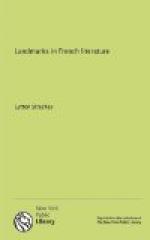autocracy of the government, and enunciated the revolutionary
doctrine that a monarch existed for no other purpose
than the good of his people. The Duc de Bourgogne
was converted to the mild, beneficent, and open-minded
views of his tutor; and it is possible that if he
had lived a series of judicious reforms might have
prevented the cataclysm at the close of the century.
But in one important respect the mind of Fenelon was
not in accord with the lines on which French thought
was to develop for the next eighty years. Though
he was among the first to advocate religious toleration,
he was an ardent, even a mystical, Roman Catholic.
Now one of the chief characteristics of the coming
age was its scepticism—its elevation of
the secular as opposed to the religious elements in
society, and its utter lack of sympathy with all forms
of mystical devotion. Signs of this spirit also
had appeared before the end of Louis’s reign.
As early as 1687—within a year of the Revocation
of the Edict of Nantes—FONTENELLE, the
nephew of Corneille, in his
Histoire des Oracles,
attacked the miraculous basis of Christianity under
the pretence of exposing the religious credulity of
the ancient Greeks and Romans. In its mingling
of the sprightly and the erudite, and in the subdued
irony of its apparent submission to orthodoxy, this
little book forestalled a method of controversy which
came into great vogue at a later date. But a
more important work, published at the very end of the
seventeenth century, was the
Dictionary of BAYLE,
in which, amid an enormous mass of learning poured
out over a multitude of heterogeneous subjects, the
most absolute religious scepticism is expressed with
unmistakable emphasis and unceasing reiteration.
The book is an extremely unwieldy one—very
large and very discursive, and quite devoid of style;
but its influence was immense; and during the long
combat of the eighteenth century it was used as a
kind of armoury, supplying many of their sharpest
weapons to the writers of the time.
It was not, however, until a few years after the death
of the great king that a volume appeared which contained
a complete expression of the new spirit, in all its
aspects. In the Lettres Persanes of MONTESQUIEU
(published 1721) may be discerned the germs of the
whole thought of the eighteenth century in France.
The scheme of this charming and remarkable book was
not original: some Eastern travellers were supposed
to arrive in Paris, and to describe, in a correspondence
with their countrymen in Persia, the principal features
of life in the French capital. But the uses to
which Montesquieu put this borrowed plot were all his
own. He made it the base for a searching attack
on the whole system of the government of Louis XIV.
The corruption of the Court, the privileges of the
nobles, the maladministration of the finances, the
stupidities and barbarisms of the old autocratic regime—these
are the topics to which he is perpetually drawing




